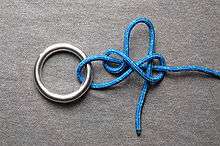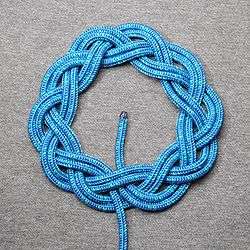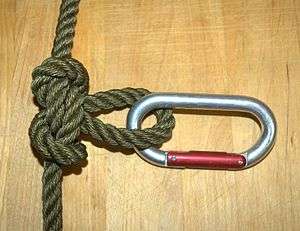Bight (knot)

In knot tying, a bite is a curved section or slack part between the two ends of a rope, string or yarn.[1] "Any section of line that is bent into a U-shape is a bite."[2] An open loop is a curve in a rope narrower than a bite but with separated ends. [3] The term is also used in a more specific way when describing Turk's head knots, indicating how many repetitions of braiding are made in the circuit of a given knot.[4]
Slipped knot
In order to make a slipped knot (also slipped loop and quick release knot), a bite must be passed, rather than the end. This slipped form of the knot is more easily untied. The traditional bow knot used for tying shoelaces is simply a reef knot with the final overhand knot made with two bite instead of the ends. Similarly, a slippery hitch is a slipped clove hitch.
In the bite
The phrase in the bite (or on a bite) means a bite of line is itself being used to make a knot. Specifically this means that the knot can be formed without access to the ends of the rope.[5] This can be an important property for knots to be used in situations where the ends of the rope are inaccessible, such as forming a fixed loop in the middle of a long climbing rope.
Many knots normally tied with an end also have a form which is tied in the bite, for instance the bowline and the bowline on a bite. In other cases a knot being tied in the bite is a matter of the method of tying rather than a difference in the completed form of the knot. For example, the clove hitch can be made in the bite if it is being slipped over the end of a post but not if being cast onto a closed ring, which requires access to an end of the rope. Other knots, such as the overhand knot, cannot be tied in the bite without changing their final form.
Examples
-

The blue rope (right) is half-hitched through and around a bite of the red rope (left) in this Sheet bend.
-

The final tuck of this Slipped buntline hitch is made with a bite rather than the end, making it easier to release after tightening.
-

In the tying of a marlinespike hitch, a bite of the standing part is snagged through the loop.
-

The bights, in the case of this 3-lead 10-bite Turk's head knot, are the scallops along the perimeter of the knot.
-

The Alpine butterfly knot is a climbing knot which is tied in the bite and forms a reliable fixed loop.
-

The Bowline on a bite forms two fixed loops in the middle of a rope.
-

An Overhand knot tied in the bite results in an Overhand loop.
-

A figure-eight knot tied in the bite results in a figure-eight loop.
References
| Wikimedia Commons has media related to Bites. |